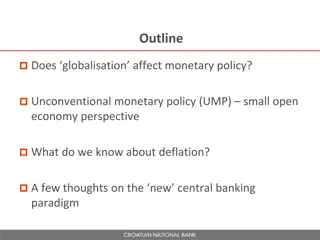Identifying Structural Shocks in Monetary Policy: Insights from Jarocinski and Swanson
Using fat-tailed distributions to identify structural shocks in monetary policy, Jarocinski and Swanson explore the effects of different policy changes such as fed funds rate adjustments, forward guidance, and bond purchases. Their findings align closely with previous research, highlighting the heteroskedastic nature of structural shocks in financial markets. The study sheds light on the complexities of interpreting stock market responses to Federal Open Market Committee (FOMC) announcements, showcasing the dynamic interactions between policy actions and market reactions.
Download Presentation

Please find below an Image/Link to download the presentation.
The content on the website is provided AS IS for your information and personal use only. It may not be sold, licensed, or shared on other websites without obtaining consent from the author.If you encounter any issues during the download, it is possible that the publisher has removed the file from their server.
You are allowed to download the files provided on this website for personal or commercial use, subject to the condition that they are used lawfully. All files are the property of their respective owners.
The content on the website is provided AS IS for your information and personal use only. It may not be sold, licensed, or shared on other websites without obtaining consent from the author.
E N D
Presentation Transcript
Discussion of Marek Jarocinski Estimating the Fed s Unconventional Policy Shocks Eric T. Swanson University of California, Irvine International Banking, Economics, and Finance Session Allied Social Science Association Meetings January 7, 2023
Structural Shocks Can Be Identified Using Fat Tails Suppose (unobserved) structural shocks in the model have very fat tails: Then large observations in the data are overwhelmingly likely to have come from either one shock or the other, not both So the econometrician can basically observe the effects of the two structural shocks separately
Financial Market Responses to FOMC Announcements are Fat-Tailed
Fat Tails in the Data Identify Four Types of Monetary Policy Shocks surprise change in fed funds rate surprise change in forward guidance surprise change in long-term bond purchases surprise change in Delphic forward guidance
Relation to Literature Results in the paper agree very closely with previous identifications despite using a completely different approach: Gurkaynak, Sack, and Swanson (2005): Forward guidance has no effect on current federal funds rate Swanson (2021): Forward guidance and long-term bond purchases have no effect on current federal funds rate Long-term bond purchases have minimal effects before 2008 Lewis (2023): Structural shocks are heteroskedastic over the course of the afternoon of an FOMC announcement
Main Comment: Delphic Forward Guidance Interpretation Stock market responses to FOMC announcements are very volatile, often difficult to explain Jan. 3, 2001: large intermeeting surprise cut in fed funds rate by 50bp intermediate-maturity futures and Treasury yields rose because markets reduce probability of recession stock market has huge increase, much more than usual Mar. 20, 2001: Fed cuts funds rate by 50bp, but markets had hoped for 75bp intermediate-maturity futures and Treasury yields fall because markets increase probability of recession stock market has huge decline, much more than usual This paper (and Jarocinski-Karadi, 2020) calls both of these announcements Delphic forward guidance , but that interpretation does not seem to fit here and is inconsistent with market commentary at the time
Main Comment: Delphic Forward Guidance Interpretation Regular forward guidance: Delphic forward guidance: The decomposition of shocks into regular forward guidance vs. Delphic forward guidance just seems like a way for the model to explain volatile stock market movements Note: excluding the stock market, three factors in Swanson (2021) explain 94% of variation in financial markets around FOMC announcements
Main Comment: Delphic Forward Guidance Interpretation Consistent with this interpretation, Delphic forward guidance effects disappear 1-2 days later: The effects of regular forward guidance are more persistent:
Summary This is a great paper The identification approach is clearly a good idea Results are consistent with previous identifications using other methods Main comment: Delphic forward guidance shock interpretation is not very convincing Delphic shocks just seem like a way for the model to explain the very volatile stock market reactions to Fed announcements Delphic forward guidance shock effects die out in 1 day























